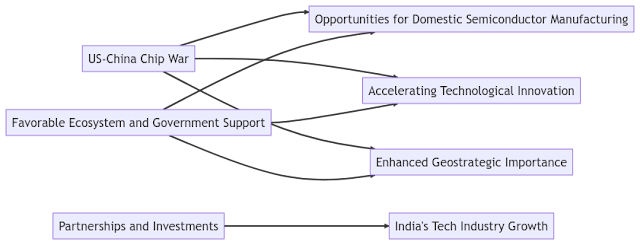In recent years, the global technology industry has witnessed a dramatic shift as the United States and China engage in a fierce competition for dominance in the semiconductor market. This escalating conflict, often referred to as the "US-China Chip War," has far-reaching consequences that extend beyond the borders of these two superpowers. In this article, we delve into the intricacies of this technological rivalry and explore its potential impact on India's rapidly evolving tech landscape.
The Semiconductor Industry: A Key Battleground
The semiconductor industry serves as the backbone of the modern digital era, powering a vast array of electronic devices, from smartphones and laptops to automobiles and advanced data centers. Recognizing the pivotal role of semiconductors, both the United States and China have intensified their efforts to secure a dominant position in this critical sector.
Rising Technological Ambitions
The United States, long considered a pioneer in technological advancements, has historically been at the forefront of semiconductor innovation. Companies like Intel, AMD, and Qualcomm have spearheaded groundbreaking research and development, enabling the nation to maintain its lead in the industry. However, China, with its ambitious "Made in China 2025" initiative, is determined to challenge American supremacy and reduce its reliance on imported semiconductors.
Strategic Importance of Semiconductors
Semiconductors are the essential building blocks of modern electronics, enabling the conversion of electrical signals into actionable information. Their widespread use in emerging technologies such as artificial intelligence, Internet of Things (IoT), and autonomous vehicles highlights their strategic importance. As a result, both the United States and China are vying to control the production, supply, and technological capabilities associated with semiconductors.
Implications for India's Tech Industry
India, renowned for its burgeoning tech industry and a growing number of tech-savvy professionals, stands at a critical juncture in the face of the US-China Chip War. While India may not be a direct participant in this rivalry, its tech landscape could experience several significant consequences.
Opportunities for Domestic Semiconductor Manufacturing
The ongoing US-China Chip War has underscored the need for countries worldwide to establish self-reliance in semiconductor manufacturing. With a large pool of skilled engineers and a thriving tech ecosystem, India possesses the potential to bolster its domestic chip manufacturing capabilities. This opens up exciting opportunities for collaborations between Indian technology firms and global semiconductor giants looking to diversify their supply chains.
Accelerating Technological Innovation
As the US-China Chip War intensifies, both nations are likely to pour significant resources into research and development, aiming to gain a competitive edge. India, being a hub for technology innovation, stands to benefit from this intensified global focus on advancements in semiconductor technology. The resulting spillover effect could catalyze a wave of innovation, fostering collaborations, and fueling the growth of Indian startups in cutting-edge domains.
Enhanced Geostrategic Importance
India's geostrategic location and its rapidly expanding digital market make it an attractive destination for both American and Chinese tech companies seeking to secure a foothold in the region. The US-China Chip War could lead to increased investment in India's tech ecosystem, promoting the development of local talent, and driving job creation in high-value sectors.
Conclusion
The US-China Chip War presents both challenges and opportunities for India's tech industry. By leveraging its technological expertise and fostering a favorable ecosystem, India has the potential to emerge as a significant player in the global semiconductor market. However, capitalizing on these opportunities will require strategic partnerships, government support, and continuous investment in research and development.
India stands at the precipice of a technological revolution, and its ability to adapt and harness the changing dynamics of the global semiconductor industry will shape its future as a leading technological powerhouse. With a strong focus on domestic semiconductor manufacturing, accelerated technological innovation, and the enhanced geostrategic importance of the country, India can position itself as a key player in the global tech landscape.


Post a Comment